At 2 days post-op after my dog’s TPLO surgery for a torn ACL, we took Tenor home from the pet hospital.
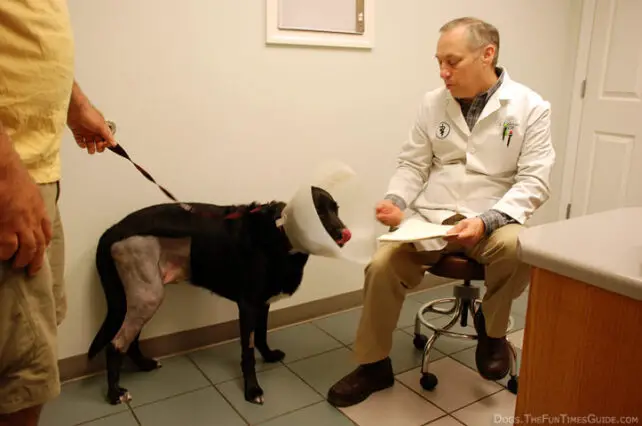
Dr. Beckman said that he was healing faster than most dogs, and he was also putting more weight on his leg sooner than most.
I think Tenor paid the price for that extra weight on his leg in those first days post-op, because his leg and ankle swelled up like an over-stuffed balloon just moments after we got him home.
Here are all the details about our dog’s recovery from TPLO surgery, as well as some tips I’ve learned from the stories of other dogs who’ve been through it…
First, here’s how to prepare your home for a post-operative dog.
You’ll want to follow that advice to make sure you’re completely ready on the day your dog returns home from surgery!
My favorites from that list:
- Create a space for your dog to be safely contained within a small space inside your home — maybe a dog crate or in the laundry room.
- Have heat packs and ice packs ready — so you can use them as needed on your dog’s sore and swollen parts.
- Make sure you have leashes handy (so you can make sure that your dog walks slowly) and towels (to help your dog up and down down stairs) — so you can grab them in a hurry for potty breaks.
- Disable the doorbell and close any curtains that your dog could see out of — to keep your dog calm for those first several days.
- Do everything that you could possibly need to do ahead of time to get things in order — like house cleaning, your work schedule, the laundry, and meal prep.
…Because once your dog gets home from surgery, all of your attention will be on the dog 24/7.
Ankle Swelling Is Okay
Even though they warned us that the ankle would swell up, they didn’t warn us how much the ankle would swell up, and how quickly! It happened almost immediately after we got him home.
It looked like a golf ball sized tumor on the side of his ankle. And you could tell it was loaded with fluid. It was very sad.
But I guess that’s why he was on mega doses of antibiotics for so long too — to avoid the chance of infection setting in with all that fluid, in addition to his body getting used to that huge metal plate and 6 screws.
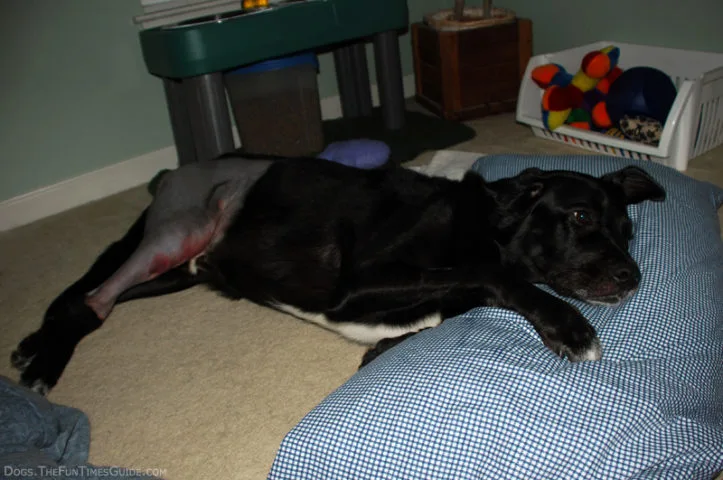
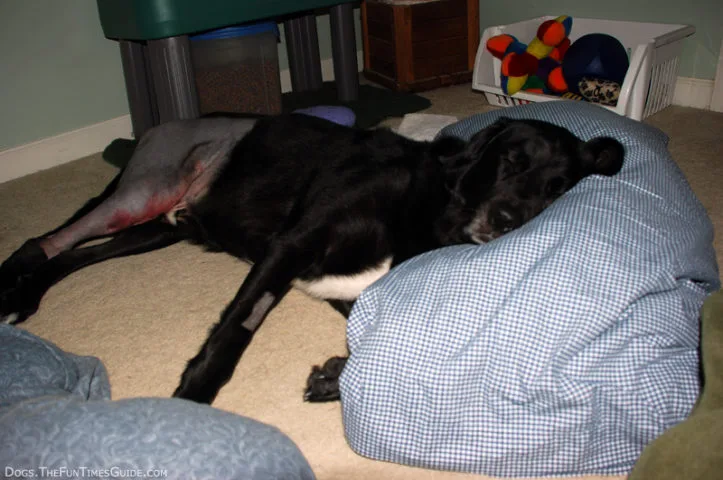
For the record, here’s what is normal after TPLO surgery, and what is not:
The Bruising Is Awful!
They also warned of a lot of bruising — which I generally think of as black & blue. Not in this case.
Tenor’s bruising was bright RED… it looked like serious rug burns, if not fire burns. And speaking of burns, it felt really hot to the touch. It was clear there was a lot of fever and draining going on inside that leg. Hence, the heavy dose of antibiotics he was on for several days following the surgery. And the red bruising actually got redder and more noticeable over the next few days.
Now, at the 7th day, most of the bruising is gone.


A Recovery Collar (aka E-Collar), A Cast, Or A Wrap?
I would’ve thought that a cast or at least a wrap would have been required to “keep things in place” after surgery — but no.
Instead, my dog was fitted with a recovery cone collar post-op, and that’s how he greeted us when we picked him up.
They said he had to keep the recovery collar on for the first 2 to 5 days he was home. But we immediately took that off of him — ONLY because we know our dog really well AND we had our eyes glued to him 24/7 during those first few days. He’s a really mellow dog (especially after surgery).
I mean, I even slept (I use that term lightly) on the floor with him to make sure I’d know if he started licking his stitches or sore ankle during those first few nights he was home. (Thank goodness for those Thermarest sleeping mats that we use when we’re camping… they came in really handy!)
Our dog is one-of-a-kind in terms of doing what we say, and he knows that No means No. (Actually, he knows that “No Lick!” means “NO LICKING!”) Still, it wasn’t until his 5th night home that Tenor even thought of trying to lick his leg wounds — it must’ve been getting itchy as the hair was starting to grow back.
UPDATE: We used a recovery collar for nights 7 through 12 post-op.
What About Going Up & Down Stairs?

We were worried about Tenor trying to use his sore leg to climb all the steps in our 2-story home.
Dr. Beckman showed us how to use a towel as a sling to lift the dog’s back-end as he uses his front legs to motor up the stairs. It worked like a charm.
By the 3rd day, Tenor was moving around well enough to tackle the stairs on his own — using only 3 legs, rather than 4. It was a cinch for him.
UPDATE: I’ve since found this dog rehabilitation harness that would probably work better than a towel. I like it because it’s perfectly sized for your dog’s weight, and it’s got sturdy handles.
Should We Be Overly Protective Of The Dog’s Sore Leg?

Doc says no, not really. Dogs know what their limits are.
For example, it’s not a problem for a dog to lie down on his sore leg after TPLO surgery. Which is exactly what Tenor did. Moments after we got home from the hospital (even with the knee and ankle swelled to their extremes), Tenor still would choose to lie down on that side of his body and sleep on that leg — on occasion.
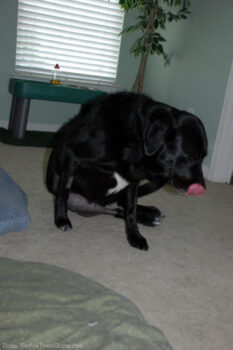
It seemed painful to me, but he would inch down, as if to work through the pain — and he would slowly lower his body to the ground on top of his bad leg. He seemed fine once he got situated.
For the most part, he would usually lay on his left (good) side, keeping his right (sore) side facing out. But after lying around for hours like this, I think his left hip would get sore from having all of his body weight on it so long, and he would have to switch to the other side.
During those times that he was lowering himself down onto his bad leg, all I could think was: “All that fluid that’s building up inside that leg — mostly around the knee and the ankle — HAS to go somewhere.” And each time he bent his knee, a lot of pressure was being put on those stitches. I vividly remembered the time our other dog’s stitches came loose and blood was leaking everywhere. But these stitches on Tenor held tight from Day One.


What About Pain Meds?
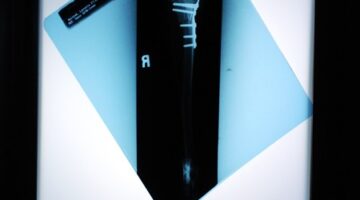
I asked the doctor about all the negative things I’ve heard about Rimadyl (and other NSAIDs too for that matter, just not to the same degree).
He agreed there are definite downsides to using those meds — especially long-term. But our dog would only be on Rimadyl for 5 days, so there shouldn’t be much to worry about.
Dr. Beckman said the “sign” that something might be going wrong is if the dog won’t eat.
No problem there!
What Is A Dog’s Appetite Like After Surgery?
Our dog ate like a pig several times a day all through his entire post-op recovery at home.
I’m guessing that’s because eating was one of the few “fun” things he could do while still lying down and not putting any weight on his leg! Truth be told, we’ve never seen our dog eat as well as he did those first few days after surgery. (I’m also guessing he didn’t eat much those 2 days he was in the hospital after surgery.)
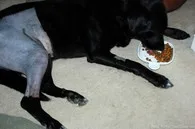
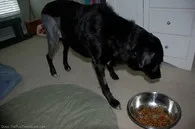
Because I didn’t want to take any chances of him not eating (and I wanted to spoil him a bit for going through the surgery), I chose to feed Tenor his all-time favorite “moist” dog food, mixed in with his daily hard food (Nutro dry dog food – Lamb & Rice).
But, quite honestly, before I gave him pills, I’d make sure he had a bit of food in him first, and I would just offer him handfuls of the Nutro dry dog food. He ate it without hesitation — which, in itself, is very unusual, because Tenor has never been a big eater.
He Hasn’t Pooped Yet!
I did get worried there for awhile, because it had been several days, yet he still hadn’t pooped. (And I knew he had a TON of food in there!) He was peeing just fine, but he made no effort to poop while he was outside.
On the morning of day 3 at home (which is 5 days post-op), he finally pooped. Not much, and it didn’t resemble any poop I’d ever seen come out of his body before. It was slightly loose and very black — tar like. We presumed this was from the heavy doses of meds that had been forced into his body.
On the next morning (day 4 at home, 6 days post-op) came our reward — a long healthy solid poop! (If you’re a dog owner, you’ll appreciate the excitement of such an occasion.)
As it turns out, you shouldn’t worry if your dog doesn’t poop for several days after surgery.


How Much Activity Is OK?
While they say your dog has to be “kept strictly confined to a small area for 8 weeks” (yep!), and he should only be led outside on a very short leash 3 or 4 times a day for “eliminations” (yep!), Dr. Beckman said it’s really only those first 2 weeks that you need to restrict the dog’s activity so much.
After that, it’s just a slow healing process that the dog will adapt to on his own, and he will slowly start to put more weight on his foot as time goes on. He assured us that we could feel comfortable leaving Tenor in the care of someone else (if we had a trip planned or something) after those first 2 weeks.
In general, veterinarians would like to see the dog’s activity be restricted for up to 8 weeks, but it’s those first 2 weeks that are really crucially important.
Turns out there are 2 different schools of thought with this:
- Some recommend no activity at all during the first 8 weeks — because it takes a minimum of 8 weeks for bones to heal and good scar tissue to form.
- Others recommend slowly introducing activity within 48 hours of surgery — as a form of physical therapy for the dog.
We actually took a middle-of-the-road approach with our dog.
After the first 3 days, we stopped trying to keep him off that leg. We figured he knew when it hurt too much and when he should take it easy. However, we did NOT let him run. He did try a few times though — in the backyard. We did our best to immediately stop him.
How Do You Prevent The Dog From Going Stir-Crazy?

After 3 days of being home and cooped up in our bedroom — other than going out to pee & poop a few times a day (and tackling many flights of stairs each time!) — Tenor was thrilled to be able to stay outside for longer periods of time.
What we did was laid down a sheet on top of the grass. (I was worried about dirt & infection near the wound.) We called this sheet his “bed” and he was happy to lie down on the sheet for awhile — just gazing into the sky and enjoying the fresh air. You could tell that he really liked the change of scenery.
TIP: If you decide to let your dog spend some time outdoors after surgery, secure a spot for him in the shade, as I would think too much sun on a fresh wound (and a hairless dog in those spots) could result in a dog sunburn and additional pain.
Dr. Beckman warned us that there might be times when a sedative would be required to keep Tenor from overdoing it — too much too soon. I’m guessing this is commonly the case with young whipper-snapper dogs who are very active. Doc gave us a couple of doggie sedatives, but I’m not crazy about using them. Only as a last resort, I guess.
Some Questions I Still Have
I plan to get answers to these at our next follow-up visit with the surgeon, Dr. Beckman.
- Do I need to worry about him jumping up or down from high places (such as the back of our Jeep, our bed, etc) after he’s fully recuperated? (8 weeks or so)
- Shouldn’t I keep a small dosage of Rimadyl or Deramaxx on hand in the event that his leg starts bothering him — like in the cold, winter months, or after he’s been playing hard or running? What about swimming?… the water is often colder than the air.
- How long until he’s allowed to run again? (It’s obvious that one month after surgery a dog that’s had TPLO surgery is likely to still be limping… I’m guessing this is true for anywhere from 2 to 3 months post-surgery.)
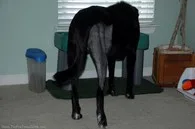

And Now For My Best Advice…

One of the best resources on the Internet regarding this type of surgery is Tucker’s story. Many of the links you see in this article refer to Tucker’s experiences. Hopefully, Tucker’s experiences, combined with our dog Tenor’s experiences, will be of assistance to fellow dog owners who are going through the same thing with their dogs.
Here’s what things were like for Tucker the day of surgery and the night of surgery.
Follow this labrador’s recovery after TPLO surgery.
UPDATE: 2 WEEKS POST-OP
Two weeks to the day after TPLO surgery, my dog started putting weight comfortably on his foot. He only did it when he was walking slowly, and you could see that it was a trial and error period for him, but we were thrilled to see him start using it again!
I was beginning to worry about so much weight being put on his other (good) foot — for one month prior to the surgery and then up to 2 months afterwards with recovery — that’s a lot of extra weight on a single (good) leg.
UPDATE: 3 WEEKS POST-OP
At 3 weeks post-op, Tenor started running (relatively hard!) on the leg that had TPLO surgery. We put a stop to the running right away, but he didn’t seem phased by it — no pain.
Also at the 3-week point:
- His fur is halfway grown in (half as thick as it should be), so he doesn’t look “naked” or “obviously shaved” anymore.
- He likes to have the outside of the bad leg rubbed (hard). And, while you can touch the inside of the leg (where the metal pin is) and he doesn’t mind it, he is more aware of it. We don’t mess with that part of his leg at this point.
- The wound is completely healed. There’s fur over the incision. No scabs remaining. No swelling. However his knee does look a little “bulky”. (Might just be an illusion since his fur has not grown completely back yet.)
- He still doesn’t sit on his hind-end evenly — meaning, his bad leg remains less ‘bent’ than his good leg when he’s in the seated position. It’s as if he leans to the left heavily on his good leg, rather than putting much seated weight on the right side of his body when that bad leg is bent. He’ll extend the bad leg all day long, and even put a good deal of weight on it, but he’s much more reluctant to bend it in as tightly as his knee should (eventually) bend.
- He thoroughly enjoys laying out in yard with the hot sun beating down on his bad leg for long periods of time. And since the fur has partly grown back, I’m not so afraid of sunburn anymore.
- Ever since the 2-week post-op point, we’ve been taking Tenor on lots of Jeep rides. He’s buckled in to the back of our Jeep Wrangler (with the seat removed), so he has lots of room to walk around back there. Each time after a ride, he’s been more inclined to walk on his bad leg without hesitation. I think it’s a form of therapy —
because he’s forced to lightly use it to balance himself when we’re turning, stopping & starting.
UPDATE: 6 WEEKS POST-OP
Tenor has been walking lightly on his TPLO leg for weeks now and he’s obviously putting more and more weight on it as the days go by.
- You can’t even tell where he was shaved anymore — though the fur isn’t quite as thick as normal yet. I think it’s that coarse undercoat that has grown in. It’s definitely not like his soft curly fur everywhere else.
- He seems to be doing really well, however, I’m actually a little surprised that he’s not walking on it more regularly by now — seeing as he’s healed so quickly and smoothly, compared to most other dogs. Nevertheless, he chooses not to walk on that leg unless he’s only going a very short distance (one side of the bedroom to the other).
- There’s no tenderness to the touch… at all. Just muscular tightness from not being used at this point. (That’s my 100% amateurish guess).
- There is a definite bulge where the plate is on the inside of his knee. And there’s a bit more “chunkiness” (not puffy, but solid) to the knee itself, compared to his other knee. Then again, it’s hard to tell apples to apples, because there’s a lot more fur on the other knee. There is clearly no swelling or pain associated with the leg itself anymore.
- He loves to have his TPLO leg rubbed — fairly hard — from high up on the hip… down on the back muscle of the leg itself… and all the way down to the toes. (I’m still leery of getting any too near that plate though.) I remember one of my early “signs” that his leg would probably be okay was when he started stretching out the toes on that leg — because it felt so good to have that leg rubbed. Now, he frequently stretches out that leg completely on his own — without incident. And he’ll ask for more when you stop rubbing it.
- Tenor will stand on his TPLO leg all day long — about 50% full pressure, only half of his actual “pad” touching the ground. But it’s obvious that he’s starting to rest more of the “pad” (rather than just the toe) on the ground as time goes by.
- He definitely won’t use that leg if he wants to get somewhere fast though. It’s as if he’s pre-programmed to run fast in a 3-legged fashion now.
- I’ve been taking him on Jeep rides since 2 weeks post-op and walking him on the leash (10 minutes tops) since 5 weeks post-op. Every time after a Jeep ride (where he’s standing a lot, sitting very little, and lying down some) he seems more balanced and confident on his TPLO leg, immediately following the ride. I guess it’s sort of forcing him to use it a bit. However, we don’t let him jump in or out of the back of the Jeep — it’s much too high for a dog with only 3 good legs.
- That said, he started jumping back up on the bed (on his own) at about 3 weeks post-op — and we actually have a relatively high king-sized bed. He jumps back down on his own too — never putting weight on the TPLO leg in either process.
- He’s obviously in no pain these days — even when he’s walked on it a bit, or (gasp) broken out into a full sprint now & then while chasing kids on the other side of the fence. That’s a big warning to those of you with a fence… even a tall privacy fence. If your dog is anything like mine, he becomes very curious whenever there’s movement on the other side of that fence, and that is the ONLY time he completely forgets about his leg. As mentioned in an update above, we’re talking full-out run on all fours. No evidence of pain, but you really shouldn’t let your dog do any serious activity like that until the 8 week point., so we stop his running immediately. Yep, 8 weeks is that magic number that we’re eagerly looking forward to.
- The only thing I’m nervous about at this point is his other knee requiring TPLO surgery soon. No signs of it or anything, but the stats, and the fact that he’s been SO overusing the good leg for so long now are what worry me. Fingers are crossed that won’t ever be necessary.
UPDATE: 7 WEEKS POST-OP
We went back to the surgeon’s office for a check-up and x-rays today.
- I was mostly concerned about the “chunkiness” in the knee area that I mentioned above (at week 6 post-op). I was afraid that maybe we’d overdone it a bit, letting him walk on it more than he should at this point or something. Doc said the bulging is merely tendinitis. It will likely flare up and go away, then come back several times throughout his life. It’s probably mixed with a bit of scar tissue as well at this point. Scar tissue generally shrinks over time. He said as long as there’s no obvious pain from all of the leg manipulations he put our dog through today, then it was nothing to worry about. (Tenor showed no signs of pain, although he typically has a very high tolerance to pain.)
- He did say that it was slightly atypical though, as he usually only sees that amount of “chunkiness” in the knee at 2 weeks post-op, then it goes away. Tenor’s appears to be a case of tendinitis that has firmly set in.
- Doc said Tenor needs 3 more weeks on restrictions (only leash walks in the yard, and no running), but the x-rays he took today show that Tenor’s knee is 90% healed at this point. He said the x-rays look good.
- I mentioned how I was concerned that his leg was making a “clicking” sound often times when he walks. The doctor was able to replicate it twice (it sounds kind of like a rubberband snapping), but he said since he couldn’t replicate it with any specific movement of the leg, it was hard to diagnose at this point. I think he said the clicking is typically a tendon, but said not to worry about it just yet.
- Doc also said since Tenor has healed so well and the x-rays look good, there was no need for us to visit the surgeon again for any follow-up visits. He’s well on his way to recovery.
- I asked if Tenor would ever be able to jump up in the Jeep on his own again, or if we should try to prevent extra-high jumping on this leg for the rest of his life. He said nope, 3 weeks from today, Tenor can go back to doing whatever he wants to do — no restrictions including jumping at great heights. (Cool! Though I have to admit, I’ll still be quite nervous.)
- Finally, doc said Tenor won’t be back to 100% normal until 4 months after his 3-week clearance date to run and play normally. It takes 4 months additional for that leg to get back into shape and rid itself of the muscle atrophy that has set in. However, Tenor doesn’t need to be restricted in any way during those 4 months. Good to know!
- Right now, Tenor is sound asleep — sleeping off the pain. We just returned from this doctor visit, and it appears that the serious amount of manipulation doc put his leg through finally caught up to him… his leg is very sore right now.
UPDATE: 3 YEARS POST-OP
Tenor has done fabulously since his TPLO surgery 3 years ago! No problems with the bad leg OR the good leg since that day. The only thing we do differently now is give him daily supplements of Glucosamine & Chondroitin to protect those joints.
By the way, a lot of people have questions about the “clicking” sound that we all seem to hear at some point from the “good” leg. I’ve mentioned in Comments previously that the clicking went away. And it did. But eventually it came back… and then went away again. That’s when I decided to start Tenor on the Glucosamine/Chondroitin supplements as an added precaution. Ideally, we probably should have started the supplements sooner after the surgery — but better late than never. The clicking sound in his leg still comes and goes.
I like to help Dog Parents find unique ways to do things that will save time & money — so I write about “outside the box” Dog Tips and Dog Hacks that most wouldn’t think of. I’m a lifelong dog owner — currently have 2 mixed breed Golden Aussies that we found abandoned on the side of the road as puppies. I’ve always trained my own dogs and help friends train theirs, as well. Professionally, I worked at a vet and have several friends who are veterinarians — whom I consult with regularly. (And just because I love animals so much, I also worked at a Zoo for awhile!) I’ve been sharing my best ideas with others by blogging full-time since 1998 (the same year that Google started… and before the days of Facebook and YouTube). My daily motivation is to help first-time dog owners be better prepared from the first day your new puppy enters your home. I like to help dog owners understand what’s ‘normal’ and what you can expect in terms of living with and training your dog — how to get through the ups & downs of potty training, chewing, teaching commands, getting your dog to listen, and everything else that takes place during that hectic first year! When I’m not training, walking, grooming, or making homemade treats for my dogs, you will find me at the corner of Good News & Fun Times as publisher of The Fun Times Guide (32 fun & helpful websites). To date, I’ve written over 600 articles for dog owners on this site! Many of them have upwards of 200K shares.






